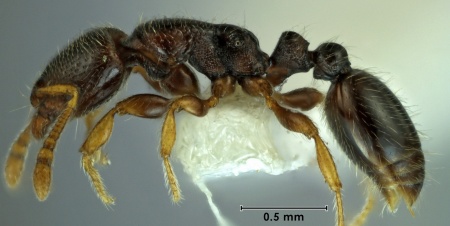Key to New Caledonian Vollenhovia Species
This key to the Vollenhovia species of New Caledonia is a working draft and is currently unpublished.
1
- Head essentially square, the sides weakly convex; central region of head with longitudinal carinae running from clypeus to posterior margin; clypeus with a pair of distinct carinae (bicarinate) => V. oblonga pedestris
- Head distinctly elongate (longer than broad), the sides nearly straight; central region of head smooth or nearly so, lacking longitudinal carinae; clypeus projecting slightly medially but lacking distinct carinae => 2
2
- Head with numerous longitudinal wavy rugae enclosing indistinct circular pits... => Vollenhovia species
- Head without longintudinal rugae, numerous distinct circular pits => 3
3
- Head longer; sculpturing on side of propodeum not extending to the level of the propodeal spiracle, the area immediately below spiracle smooth; dorsal face of propodeum similar in length to posterior face => V. denticulata pale form
- Head shorter; sculpturing on side of propodeum extending to the level of the propodeal spiracle, the area immediately below spiracle punctate; dorsal face of propodeum longer than the posterior face => V. denticulata dark form
Note: Emery's original concept of V. denticulata included both colour forms as variants of a single species. It now appears that more than one species is involved. To secure the name denticulata to one of these forms a lectotype will need to be designated, leaving the other form free to be named as a new species.








